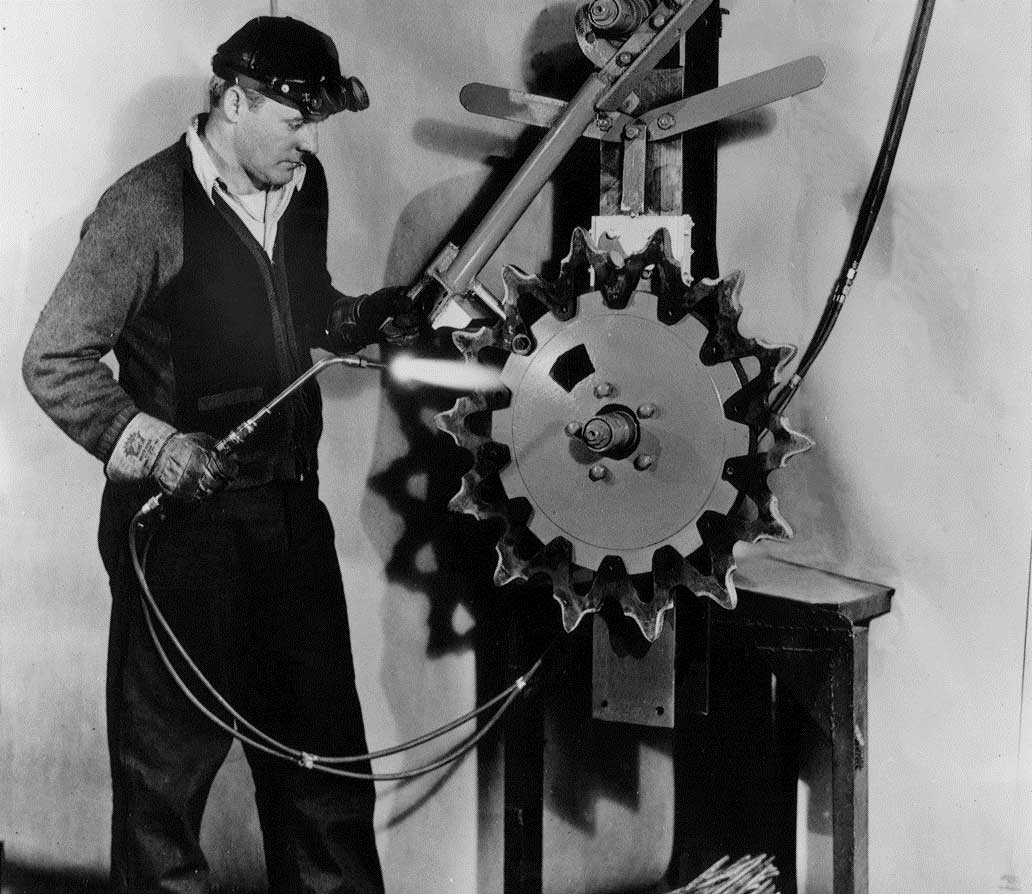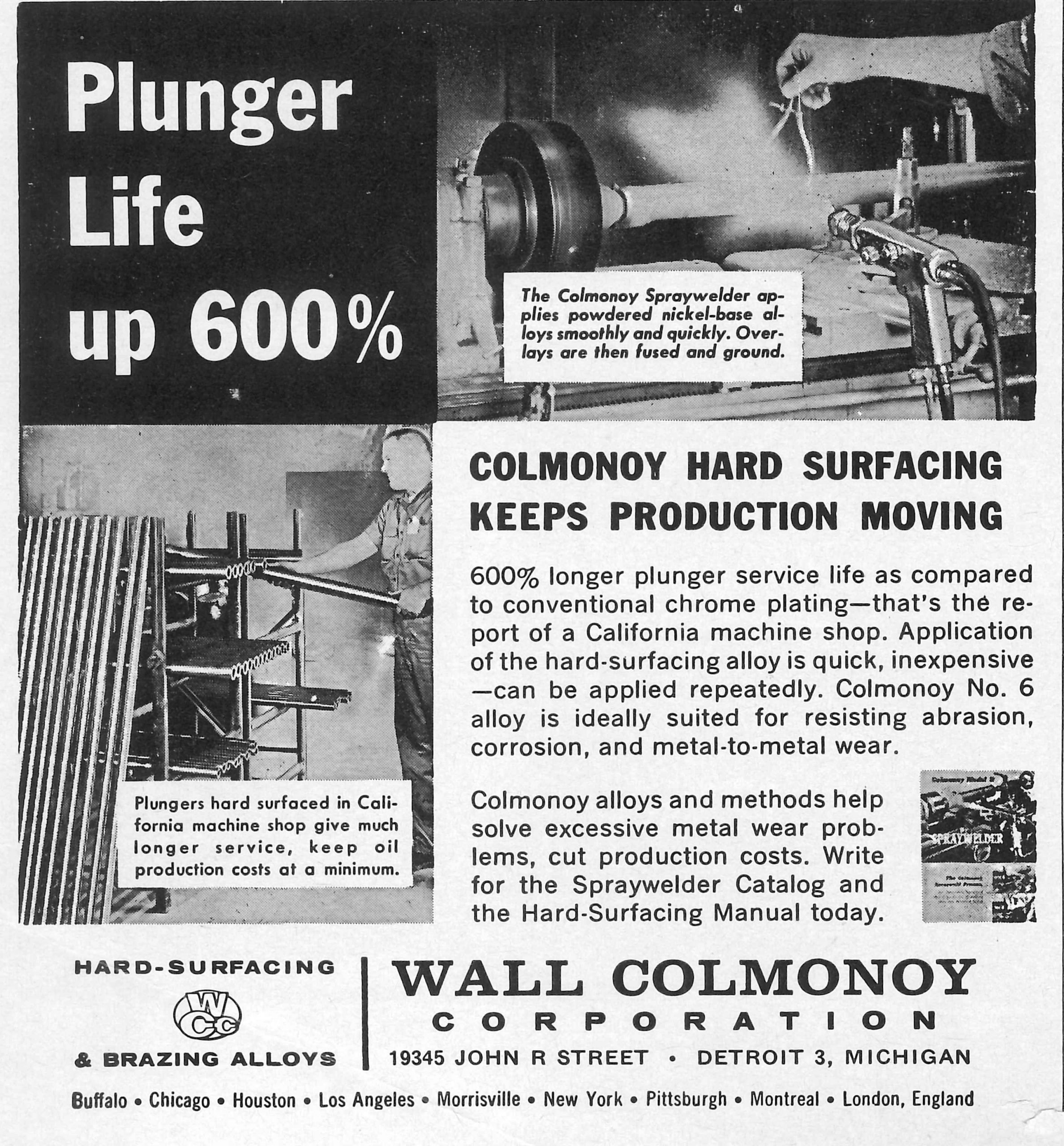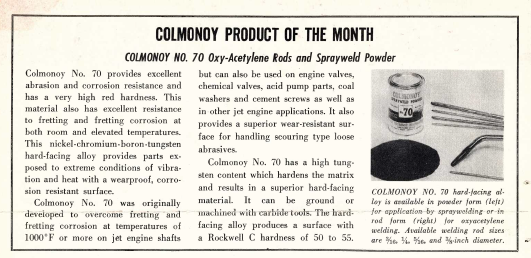
The first nickel-based hardfacing alloy, Colmonoy® was developed by two metallurgists Mr. Norman Cole and Mr. Walter Edmonds in 1937. Colmonoy® was first utilized extensively to extend the useful service life of downhole tools and drill bits for the oil industry.
During World War II, Colmonoy® was used to extend the lifespan of U.S. Army tank parts, such as drive gears and track sprockets.

Colmonoy® nickel-based hard facing alloy was used during WWII on U.S. Army tank parts
Colmonoy® 6 – the first nickel-based hardfacing alloy
Colmonoy® 6 was one of the first alloys to be created and marketed. Colmonoy® 6 offered extreme abrasion resistance and also resistance to corrosion and high heat. With a hardness of 56-60 Rc, this nickel-based hard facing alloy exhibited corrosion characteristics similar to Inconel.

Advertisement from 1964 explaining the benefits of Colmonoy® 6 powder increasing plunger life by 600% – keeping production moving and cutting costs due to its abrasion, corrosion and metal-to-metal wear resistance.
Colmonoy® 4 & 5 – developed based on customer requirements
The next alloys developed were Colmonoy® 4 and Colmonoy® 5. As needs developed, Colmonoy® 4, 5 and 6 nickel-based hard facing alloys . The hardness levels of Colmonoy® 6, 5, and 4 are 60 Rc, 50 Rc and 40 Rc respectively. The reason for lower hardnesses were for machining requirements. One did not need, for their wear, a material with a hardness of 60 Rc. For example, when coating pump valves, a material such as Colmonoy® 4 (which is only 35-40 Rc) will outwear hard chrome plating by 5 to 10 times. The original powder alloys, Colmonoy® 6, 5, and 4, were unique not only that they contain chromium bodies but that they are also crushed and milled powder.

Advertisement from the 1960s promoting Colmonoy® 6, 56, 5 & 4 nickel-based alloys for coating of gates, plugs, seats, stems and valve parts (new or repair).
Self-Fluxing Alloys – fuses across a variety of base metals
Regardless of form, whether rod or powder, Colmonoy® alloys have another important feature. As well as being primarily nickel-based, Colmonoy® also contain silicon and boron. The nickel, silicon and boron trio create a self-fluxing alloy that fuses not only to itself, but a wide range of metallic base materials including carbon steel, tool steel, dye steel, stainless steel, and cobalt alloys.
![]()
Colmonoy® nickel-based hardfacing alloys also contain silicon and boron. The nickel, silicon and boron trio create a self-fluxing alloy that fuses not only to itself, but also to a variety of base metals.
Development of nickel-based alloys for new benefits in wear and corrosion resistant properties
Since its beginnings, the nickel-based hardfacing alloy has evolved. Other elements have been added to turn Colmonoy® into a whole range of rods and atomized powders, bringing new benefits in wear and corrosion resistant properties.
Colmonoy® nickel-based hardfacing alloy line has expanded to meet different customer needs. Colmonoy® 56 was introduced for the plastic extruder industry. With a hardness of 50-55 Rc, Colmonoy® 56 fall right between Colmonoy® 5 and Colmonoy® 6.
Colmonoy® 70 was developed for Pratt & Whitney Aircraft Company to satisfy their needs for a material that would not fret “intergranular corrosion”. The tungsten additive offered corrosion resistance at high temperatures which was required on the tie rods of one of their engines.

Colmonoy® 70 Rod and Sprayweld Powder as Product of the Month in 1956 Alloy News Bulletin.
As Colmonoy® progressed there was a need for more tungsten carbide bearing alloys. Variations of the original nickel-based alloys were made and tungsten particles were added by different percentages. Futher on, special mesh powders were developed to go through what is known as puddle torch equipment, Fusewelder designed for hand powder spraying and simultaneous fusing.
A new family of exothermic type metallizing powders were introduced in 1984. SoloCoat™ metallizing powders which have exceptionally high bond strengths. SoloCoat™ powders are available in many coating grades from machinable to hard grindable. SoloCoat™ is excellent for combating wear and corrosion. SoloCoat™ coatings are used for rebuilding, repairing and for protection of original equipment parts.
Since the original alloys, Wall Colmonoy has created new materials and developed new fields for their use. Today, there are 70+ Colmonoy® alloys, in a variety of forms, to protect metal equipment from abrasion, high heat and other wear inducing phenomena.
Want to know more about Colmonoy® alloys or have a technical question?